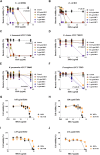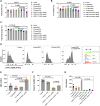The synergistic activity of SBC3 in combination with Ebselen against Escherichia coli infection
- PMID: 36588729
- PMCID: PMC9797518
- DOI: 10.3389/fphar.2022.1080281
The synergistic activity of SBC3 in combination with Ebselen against Escherichia coli infection
Abstract
Escherichia coli ranks as the number one clinical isolate in the past years in China according to The China Antimicrobial Surveillance Network (CHINET), and its multidrug-resistant (MDR) pathogenic strains account for over 160 million cases of dysentery and one million deaths per year. Here, our work demonstrates that E. coli is highly sensitive to the synergistic combination of SBC3 [1,3-Dibenzyl-4,5-diphenyl-imidazol-2-ylidene silver (I) acetate] and Ebselen, which shows no synergistic toxicity on mammalian cells. The proposed mechanism for the synergistic antibacterial effect of SBC3 in combination with Ebselen is based on directly inhibiting E. coli thioredoxin reductase and rapidly depleting glutathione, resulting in the increase of reactive oxygen species that cause bacterial cell death. Furthermore, the bactericidal efficacy of SBC3 in combination with Ebselen has been confirmed in mild and acute peritonitis mice. In addition, the five most difficult to treat Gram-negative bacteria (including E. coli, Acinetobacter baumannii, Enterobacter cloacae, Klebsiella pneumoniae, and Pseudomonas aeruginosa) are also highly sensitive to a synergistic combination of SBC3 and Ebselen. Thus, SBC3 in combination with Ebselen has potential as a treatment for clinically important Gram-negative bacterial infections.
Keywords: Escherichia coli; SBC3; ebselen (PubChem CID: 3194); peritonitis; redox homeostasis; thiol-dependent redox system.
Copyright © 2022 Chen, Lu, An, Li, Shen, Zheng, Chen, Wang, Li, Du, Wang, Liu, Baumann, Tacke, Zou and Wang.
Conflict of interest statement
The authors declare that the research was conducted in the absence of any commercial or financial relationships that could be construed as a potential conflict of interest.
Figures





References
-
- Chattopadhyay S., Weissman S. J., Minin V. N., Russo T. A., Dykhuizen D. E., Sokurenko E. V. (2009). High frequency of hotspot mutations in core genes of Escherichia coli due to short-term positive selection. Proc. Natl. Acad. Sci. U. S. A. 106, 12412–12417. 10.1073/pnas.0906217106 - DOI - PMC - PubMed
LinkOut - more resources
Full Text Sources
Molecular Biology Databases
Miscellaneous

